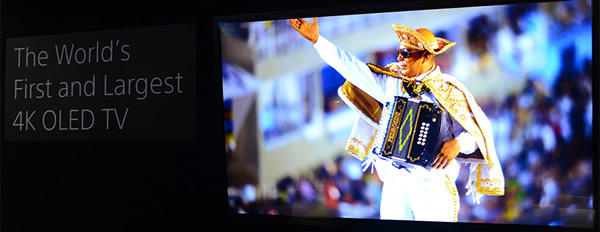Although they're some of the smallest UHD-capable models you'll likely find, 56-inch televisions from both Sony and Panasonic are not only boasting UHD resolutions -- they are also OLED. These prototype TVs have turned the heads of Cnet, Gizmodo and others but it may be some time before we actually see OLEDs like these hit mass market.
Although there are no official prices, Cnet supposes the Sony will run about $5,000. If that turns out to be an accurate prediction, that's an enormous improvement over current UHD televisions which sometimes cost more than a down payment on a home (not even OLED!). Given that LG announced their own 55-inch OLED TV for ~$10,000, ~$5,000 may be somewhat optimistic. Prices should be announced in about a week though, so we'll find out for sure soon.

We recently noted that UHD televisions from a number of manufacturers were going to appear at CES -- some even as large as 84-inches. Measuring 3840 x 2160, UHD effectively packs quadruple the pixels of 1080p. Bigger numbers are typically better, but there are some concerns with UHD: you may actually need one of those enormous 84-inch TVs to appreciate the details.
Although not OLED, Sony will be releasing a series of UHD/4K TVs as early as this spring. The question is though: what do you view on a UHDTV? Not much, really -- there aren't any mainstream sources for 2160p material. However, Sony hopes to fix this by providing its own, dedicated UHD content delivery service. Lack of details regarding the service has kept it rather non-descript, but one bonus to buying a Sony UHD TV will be an included bundle of 4K Blu-ray discs.
The X series of 4K LED TVs will be available in spring 2013 at Sony Stores and select electronics retailers in the US. Also available in spring will be a lineup of Mastered in 4K Blu-ray discs from Sony Pictures' ColorWorks Studio. The first titles to be available are The Amazing Spider-Man, Lawrence of Arabia and Taxi Driver. Sourced from pristine 4K masters and presented at high-bit-rate, full HD resolution, these discs showcase more of the wide range of rich color contained in the original source content. When upscaled via the Sony 4K Ultra-HD LED TVs, these discs serve as an ideal way for consumers to experience near-4K picture quality.
Source: cnet.com
You may also see such TVs labeled as "4K", but that seems a bit disingenuous. UHD is a pragmatic attempt to make life less painful to most people updating 1080p in neat multiples. In this case, 1080 x 2 = 2160. On the other hand, "4K" is a term which has been steeped in professional use, denoting resolutions that are typically 4096 pixels across. 4K will likely take on new meanings though as UHD catches on and manufacturers keep pushing "4K" as a consumer buzz word. "4G" and "LTE" are prime examples.
Long considered the holy grail for televisions, OLED promises brighter and thinner displays with superior contrast and lower power consumption. Panasonic's 56-inch OLED, for example, weighs just 27 pounds and falls short of a half-inch thick. By the looks of it, a number of manufacturers like Samsung and LG will be releasing their own OLEDs soon, although not necessarily UHD.
https://www.techspot.com/news/51275-panasonic-sony-show-off-56-inch-uhd-4k-oled-tvs.html